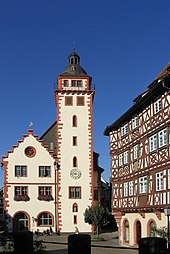Town Hall (Mosbach)
The town hall of Mosbach in the Neckar-Odenwald district in northern Baden-Württemberg was built in 1557/58 on the foundations of a Catholic Church of St. Cecilia that was closed in the course of the Reformation in the Electoral Palatinate .
history
Early history as a church building
Today's market square in Mosbach was once the cemetery of the Mosbach collegiate church . In the south-western area of the cemetery there was a walled area with a Cecilia chapel as well as an ossuary and a bahrhäuschen. The Cäcilienkapelle was probably laid out in the 9th century and in the 11th century it was consecrated as a St. The oldest structurally verifiable parts of the building date from the Romanesque period and leave a choir tower with a tower in the east on an almost square floor plan of 5.85 × 5.05 meters and a rectangular nave with a floor area of around 9.40 meters to the west × 16.50 meters.
Around 1290, the chapel was extended by about 6.5 meters to the south and about 9 meters to the west and thus essentially to the current building floor plan and used in future as the Church of St. Cecilia, in 1291 a parish church is documented in connection with a St. Cecilia altar. The bell tower, whose basement was already the tower choir of the old chapel, was probably 25 to 30 meters high after the renovations around 1300. The church was affiliated to the land chapter Buchen, the patronage right lay with the collegiate monastery in Mosbach.
In the early 16th century the church had three altars. The high altar was consecrated to Cecilia , one of the side altars to Vitus . The long house had a gallery in the back and a mount of olives with a stone fence.
Closure of the church during the Reformation
In the course of the Reformation in the Electoral Palatinate , church services were no longer celebrated in the church from 1545. In 1546 the foundations belonging to the church were added to the urban poor. Elector Ottheinrich ordered the closure of the old Catholic parish church of St. Cäcilia in 1556, as he no longer tolerated Catholicism in his principality according to cuius regio, eius religio . The Cäcilienkirche was then left to the city for demolition in 1557 and converted into the town hall from 1558. In the course of the conversion, the old inner-city cemetery area was cleared and converted into a market square, and the new cemetery was the cemetery at the mansion complex outside the city walls.
The rib-free cross vault on the ground floor of the original church building, resting on sandstone pillars, has been preserved. The tower was dismantled down to the lower third and rebuilt higher than before, with a bell room again until 1566 and the old Cäcilienglocke from 1458 continued to be used as the town hall bell. The ground floor of the building served as a market hall, on the first floor there was the Ratsherrenstube and the city archive, on the second floor there was a dance floor and at times also the local Latin school . The attic served as a granary.
Use as town hall
The oldest known view of the building dates from 1832. The building gable facing the market square was originally designed as a curved volute gable with three windows and was only given its current shape as a stepped gable with a round window during renovations in the 19th century . The double staircase leading to the main entrance on the broad side of the building was roofed in the 19th century, and the entire building was slated. On the tower survived until 1909, a watchman in the tower basement, the drunk tank was located.
The town hall was extensively renovated in 1976/77 by city architect Wolf, whereby the room layout inside was also changed by demolishing old fixtures and installing new partition walls. As some office rooms were relocated to the adjoining and in the future included former Hotel Krone during the renovation , the ground floor with large and small council rooms could be kept free for various event purposes. In the Bürgersaal on the first floor, the meeting place of the municipal council, the original color of the ceiling beams was restored. The basement of the tower, once the tower choir of the Nikolauskapelle, was prepared as a chancel.
literature
- St. Cäcilia in Mosbach 1935–1985 - Church life in the past and present , Verlag Laub, Elztal-Dallau 1985
- Ernst and Dorothee Brüche: Das Mosbach Buch , Verlag Laub, Elztal-Dallau 1987
Web links
Coordinates: 49 ° 21 '7.1 " N , 9 ° 8' 44.9" E

